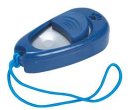General Articles
Clicker Training with Victoria James
...and Champagne.
Animal Training: The Clicker
What is the Clicker and why do we Use It?
- What is the clicker? The clicker is a small device that has a tab on the back, that when pressed makes a ‘click’ sound.

-
The clicker is a fantastic training tool that enables you to shape the behaviour of your pet very effectively!! Of course clicker training is brilliant fun too!!!The clicker can be used to train a wide variety of companion animals from your dog, cat, rabbit, parrot or your horse.
-
The clicker is what we call a ‘bridge signal’, it bridges the gap between a good behaviour being performed and reinforcement being provided; essentially it bridges the gap between these two events.
-
Reinforcement is anything your pet finds reinforcing, for example a toy, lots of cuddles etc. When training, we typically use praise and treats or just praise.
-
This is how the clicker is applied: Good Behaviour is displayed, the click is provided and then following reinforcement is provided. This is carried out in a sequential order, e.g.: you will give your dog a command and hand signal to sit, once your dog has sat, you would click following the behaviour being completed so your dog knows they have displayed the correct behaviour. Immediately after you have clicked, you then would provide your dog praise and a treat or just praise, depending on what your dog most responds too and enjoys.
-
The clicker is used because it is consistent, the sounds stays the same all the time, whereas your voice tone changes from day to day. This consistency is very important when training.
-
We use the clicker because it is very effective. When you use the clicker, your dog will associate the sound of the clicker with the reinforcement therefore knowing what they have carried out the correct behaviour. Essentially the clicker takes on the meaning of the food reinforcement/praise reinforcement and as soon as you click, your dog knows they have carried out good behaviour.
-
As a pet associates the sound of the clicker with reinforcement and positive events, it can be used to train behaviour very effectively.
-
As you have only a certain amount of time to reinforce behaviour so your pet makes an association with the behaviour they have carried out and the reinforcement provided, the clicker is used to immediately reinforce behaviour. The clicker is quick (as long as you as the trainer develop good timing when clicking, which does develop quickly with a bit of practice!), meaning you can very effectively reinforce behaviour because of its association with reinforcement– ‘as soon as you click, your pet knows they have done the correct thing’. It also provides you time to reach into your bumbag to get a treat. The treat again should be provided immediately after the click (note: not at the same time but just after the click) so the association between clicker and reinforcement is maintained.
-
Be sure to purchase a bumbag that you feel comfortable with and that you can reach into to get the treats easily. This will mean your behaviour will be deliberate and good timing with clicking and treating can be maintained.
-
Once the clicker has been conditioned, in other words your pet knows its meaning and what it signifies, you can train lots of behaviours and it can be applied to training good behaviour and showing your pet how you would like them to behave, this is why the clicker and good training techniques are used to treat behavioural problems, so we can positively shape alternative good behaviours other than any unwanted or none desirable behaviour your pet may be displaying. You can also train fun behaviours like going through tunnels, doggy dancing behaviours, jumping through hoops, even basic obedience behaviours, like sit and stay and much much more!!
-
When training behaviours we often employ the technique of shaping. This means we break down a behaviour into small stages that an animal is able to learn. This way we make it easier for an animal to master different behaviours as the animal learns each approximation of a behaviour until the finished behaviour is completely trained. This approach allows the animal to learn in stages. Sometimes to train a complete behaviour, especially if complex can be too much for an animal to learn in one process, so we break this down into little stages the animal can achieve. Remember your pet must always be set up to succeed!! This allows us to encourage the animal we are working with, saying you are ‘almost there’, you are ‘almost there’ and we as trainers, like an artist creating a painting, shape and create behaviour. As the behaviour starts to form, building approximation on approximation (like building brick upon brick when building a house), you can gradually get nearer to the final behaviour we want to shape. Once the behaviour is almost or fully trained, we can add a hand signal and voice command so the behaviour is under ‘stimulus control’, meaning we can ask the animal we are training to carry out the behaviour whenever we would like and we can signal the animal to carry out the behaviour.
-
It is very important when shaping to always shape upwards when training a behaviour. You can of course, re-trace some steps you took to train the behaviour if you feel the animal you are working with is struggling or perhaps you have taken too big of a step when training the behaviour and you need to back-track and train in smaller steps but as a general rule you must always shape better progressions of the behaviour. You also must not click and reinforce a behaviour unless it is to the same standard you know your pet can achieve. By clicking and reinforcing in this way you can maintain a good level of the behaviour you have trained. The approximations you decide to use will depend on the animal concerned, each animal will learn differently and at a different pace. There will be a detailed video coming soon on ‘Shaping’ Watch this space!!!
-
WE ALSO USE TREATS TO LURE PETS INTO POSITIONS AND GUIDE THEM INTO BEHAVIOURS, AS WELL AS OTHER TRAINING AIDS TO TRAIN BEHAVIOUR FOR EXAMPLE, TARGET STICKS.
PLEASE KEEP CHECKING THE PET CORNER FOR MORE INFORMATION. ‘SCANNING’ IS ONE EXAMPLE OF ANOTHER TYPE OF TRAINING METHOD WE USE TO PUT EXCITING BEHAVIOUR ON CUE WITH THE USE OF THE CLICKER.
AGAIN KEEP TOUCHING BASE WITH US TO LEARN ABOUT THESE INTERESTING ANIMAL TRAINING TOOLS!!
How do you Start Clicker Training?
-
The clicker can be used with many companion animals for example your dog, rabbit, cat or horse etc., so start clicker training your pet today!!
-
You can contact me for some professional advice for doing this. It does help to have a professional trainer by your side but here is some basic information below.
-
Purchase a bumbag.
-
Fill bumbag with some of your pets favourite treats!
-
When you are chilling out with your pet, you can make a start!
-
Practice just giving a click, then providing praise and a treat, repeat this several times, you will start to see when your pet is becoming conditioned to the clicker and seems to recognise what is signifies. Your pet will generally look up at you expecting the provision of reinforcement. Remember a sequential order, click, then reinforce, one event after the other and as immediate as you can. Practice good timing here and hone your clicker skills!!
-
You can do this over several sessions.
- If your pet is sound sensitive, use a Multi-Clicker, which has three different tones which can be changed using the notch on the front of the clicker. You can start with a low tone and build the tone up as your pet gets more comfortable or alternatively continue to use the same tone. With a noise sensitive pet, you may like to start holding the clicker behind your back or at a distance from your pet. The Multi-Clicker is a good quality clicker to use even if your pet is not noise sensitive.
-
DO NOT hold the clicker near your pet’s face or near ears; just hold the clicker by your side.
-
Once your pet has learnt the meaning of the clicker, you are all set to start training some fab behaviours, whilst having tremendous fun with your pet!!!
-
WATCH THIS SPACE AND KEEP TRACK OF MY PET CORNER TO SEE WHAT YOU CAN NOW TRAIN YOUR PET TO DO WITH YOUR CLICKER!
-
Note: Rules with the clicker – only use the clicker as a ‘bridge signal’, in other words only after good behaviour has been performed so the meaning of the clicker can be maintained. Do not use it to gain your pet’s attention, only use in the context described above. Be responsible when using the clicker, if you would like to get your children involved with training, it is important you first start the training process with your pet and once training is going well, you can get the whole family involved but be sure to supervise children, showing them how to use the clicker. Be sure behaviour is as you would like it before clicking and if you click by mistake, still reinforce for the association of the clicker to be maintained.
-
Clickers are available from all good pet stores.
-
Please do contact me for more information!
-
It is always good to have the help of a professional when starting clicker training, do some research and employ the services of an ethical and professional trainer employing positive training methods!!!
-
Follow the guidelines set out above.
-
Enjoy and have fun with your pet !!
Email: victoriaspettraining99@yahoo.co.uk
or call me: +33 (0)6 89 19 50 88



